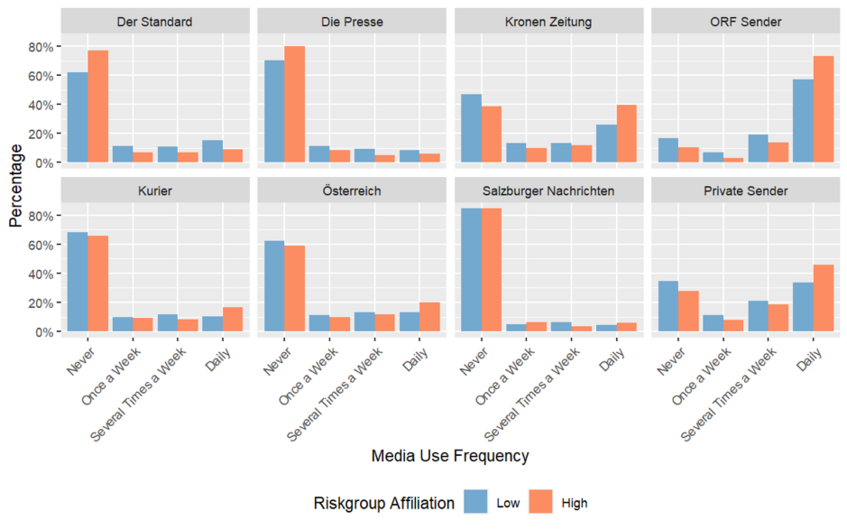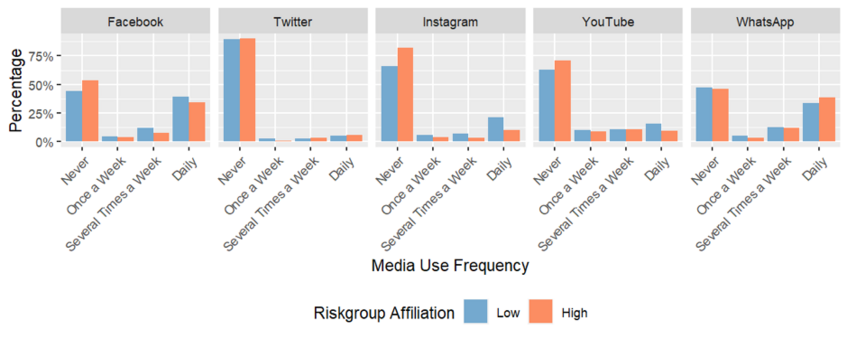06.04.2020
Old and New Media: Media Use in Times of the Corona Crisis
- Public broadcasting is the most widely used source of information on the Corona crisis.
- 11% of the population is reached neither by traditional nor by social media.
- Both high- and low-risk groups are more likely to inform themselves through traditional news media than social media. High-risk groups tend to use traditional media more frequently than other parts of the population.
- Generally, social media, such as Facebook, Instagram, and YouTube, are more likely to be used by the low-risk group. Only WhatsApp is used slightly more often by the high-risk group.
By Noelle S. Lebernegg, Jakob-Moritz Eberl, Hajo G. Boomgaarden und Julia Partheymüller
Media constitute one of the most important sources of political information for citizens, including traditional news media as well as digital and social media. Currently, new measures, scientific findings, and forecasts on the spread of the coronavirus are discussed in Austrian media almost daily. But not all citizens inform themselves to the same extent and through the same channels. This is partly due to the fact that not all people face the same health risk; however, demographic, economic, and social factors also play a role.
The identification of suitable information channels is of vital importance for governments as well as health organisations in order to reach these different groups equally. Hence, in the following, we aim for a clarification of this question based on the data retrieved from the first wave of our panel survey.
Both traditional and social media are frequently used
First, we divided participants into low- and high-risk groups. In the high-risk group, we included all those aged 65 and over, as well as those suffering from any relevant pre-existing conditions, such as cardiovascular diseases, diabetes, hepatitis B, chronic obstructive pulmonary disease, chronic kidney failure, cancer (approx. 30% of all respondents). The remaining respondents were defined as a low-risk group (approx. 70%). Next, we determined the media use of Austrians during the corona crisis. To do so, we examined which media were used to what extent, while distinguishing between traditional news media (i.e., daily newspapers, news channels, and their online counterparts; see Figure 1) and social media (Figure 2).
Our results indicate that an overwhelming majority of respondents (80%) obtain information at least once a day through one or more traditional news media. This proportion is significantly higher in the high-risk group (88%) than in the low-risk group (77%). However, social media are also an important source of information across all population groups. More than half (57%) of those surveyed use them at least once a day. Although media use naturally correlates with many other characteristics - e.g., age, education, or ideology - it can be stated that the low-risk group is somewhat more active on social media (59%) than the high-risk group (53%). Only 11% of the population does not use any of the information channels under consideration on a daily basis (12% of the low-risk group; 8% of the high-risk group).

Figure 1: Traditional media use (i.e., daily newspapers and news channels) by risk group affiliation (Notes: Field time: March 27-30, 2020, N=1,521 respondents (14 years and older), data weighted representative for the Austrian population).

Figure 2: Social media use by risk group affiliation (Notes: Field time: March 27-30, 2020, N=1,521 respondents (14 years and older), data weighted representative for the Austrian population).
When taking a closer look at the results, it can be seen (Figure 1) that the information offered by public broadcasting is of particular importance to our respondents (i.e., 62% obtain information there on a daily basis; 73% of the high-risk group and 57% of the low-risk group). Generally, most of the traditional news media surveyed tend to reach the high-risk group to a greater extent than the low-risk group. The two quality newspapers Der Standard and Die Presse are an exception thereof.
Among the social media (Figure 2), Facebook (38%) and WhatsApp (35%) are mainly used for daily information gathering. Only WhatsApp is increasingly used by members of the high-risk group as a daily source of information (38% to 34%).
What is the best way to distribute high-quality information?
In summary, it can be said that in times of crisis, there is a very high demand for information among the population. If the aim is to inform a large part of the population quickly, this is probably best achieved via public broadcasting. The fact that WhatsApp is considered an important source of information for people in the low-risk and, in particular, high-risk sectors is a cause for concern, as much disinformation about the virus is spread via this platform in particular. Fortunately, however, it is also becoming apparent that the high-risk group is at the same time keeping itself increasingly informed via traditional news media - this provides an opportunity to correct misinformation.
If population groups differ in their media use and media diets, this can also affect their knowledge about the virus or their perception of the crisis. Furthermore, differences in media use may be related to a lack of media trust or may be rooted in divergent expectations of journalism. We will deal with these and other topics in more detail in the coming weeks.
Noelle Lebernegg is a University Assistant (Prae-Doc) at the Department of Communication at the University of Vienna and an associate researcher at the Vienna Center For Electoral Research (VieCER). She focuses on the impact of political communication and media on public opinion and voting behaviour.
Jakob-Moritz Eberl has been a post-doc at the Department of Communication at the University of Vienna since April 2017 and a member of the Austrian National Election Study (AUTNES, Media Side) since 2013. He is also an associate researcher at the Vienna Center for Electoral Research (VieCER) and deals with questions on media effects, media trust and voting behaviour.
Hajo Boomgaarden is Professor of Methods in the Social Sciences at the Department of Communication at the University of Vienna and currently Dean of the Faculty of Social Sciences. His research focuses on the presentation and impact of politics in the media.
Julia Partheymüller works as Senior Scientist at the Vienna Center for Electoral Research (VieCER) at the University of Vienna and is a member of the project team of the Austrian National Election Study (AUTNES). She received her doctorate in social sciences at the University of Mannheim and studied political science at the Free University of Berlin and the University of Hamburg.
Related Blog Posts
- Blog 12 (EN) - Most people take the situation seriously. But who are the Coronavirus skeptics?
- Blog 15 (EN) - Of Misunderstood Snoopers and Other Anti-Coronavirus-Activists
- Blog 21 (EN) – Old And New Media: Disinformation in Times of the Corona Crisis
- Blog 40 (EN) - Audience Expectations of Coronavirus Reporting: From Watchdog to Lapdog?
